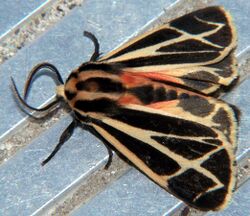Biology:Apantesis phalerata
| Harnessed tiger moth | |
|---|---|

| |
| Scientific classification | |
| Domain: | Eukaryota |
| Kingdom: | Animalia |
| Phylum: | Arthropoda |
| Class: | Insecta |
| Order: | Lepidoptera |
| Superfamily: | Noctuoidea |
| Family: | Erebidae |
| Subfamily: | Arctiinae |
| Genus: | Apantesis |
| Species: | A. phalerata
|
| Binomial name | |
| Apantesis phalerata (Harris, 1841)
| |
| Synonyms | |
| |
Apantesis phalerata, also known as the harnessed tiger moth, is a moth species of the family Erebidae. It was first described by Thaddeus William Harris in 1841.[1][2]
Range
Native to North America, A. phalerata's range extends from Ontario, Quebec and Maine to Florida, Texas , and South Dakota. A. phalerata are typically active from April to September in the southern portion of the range, and from May to August in the north.
Life Cycle & Behavior
As caterpillars, A. phalerata feeds on grasses, garden crops, shrubs, and trees, such as Trifolium (clover), Spartina (cordgrass), Taraxacum (dandelion), and Plantago (plantain) species, as well as other low-growing plants. Like all butterflies and moths, harnessed tiger moths undergo a complete metamorphosis, with four life cycle stages: egg, larva (caterpillar), pupa, and adult. The cocoon is constructed mostly from larval hairs.
A. phalerata have a wingspan of 30–42 mm (1.2–1.7 in). They are characterized by their black and orange patterned wings, hence the name "tiger" moth. Like other tiger moths, it employs aposematism in order to discourage predators.
The harnessed tiger moth is predated upon by bats, which employ echolocation as their primary sensory mechanism for detecting prey, and are thus not discouraged by A. phalerata's bright colors.
References
- ↑ Savela, Markku. "Apantesis phalerata (Harris, 1841)". https://www.nic.funet.fi/pub/sci/bio/life/insecta/lepidoptera/ditrysia/noctuoidea/arctiidae/arctiinae/apantesis/#phalerata. Retrieved August 6, 2019.
- ↑ Cirrus Digital: "Harnessed Tiger Moth Apantesis phalerata".
External links
Wikidata ☰ Q4779110 entry
 |

